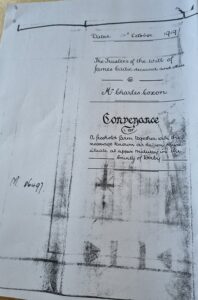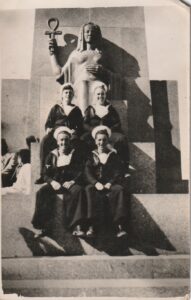What to keep and what to leave behind
The ABC has recently been promoting a new series featuring Shaun Micallef called Eve of Destruction. The premise of the series is to discover from a number of celebrities what is really important to them. I have seen a similar scenario on Antiques Roadshow where the experts are asked to select the three most important things they would take if they had to leave their home suddenly. It seems to me that the ‘things’ themselves are not necessarily what is the most valuable, it is the memories and experiences that they evoke in the individual. What is important to one person would not necessarily be important to another family member for instance.
I travelled to England in 2023 at short notice when my mother passed away. It fell to me, among other things, to sort through the things she had accumulated in her 98 years, and decide what to keep, what to bring back to Australia, what to share with other family members as mementos of a mother, grandmother and great-grandmother. As well, what to dispose of and, as I had a limited amount of time, what to leave for another day. My mum will feature in my next blog post in October.
This exercise brought to mind that I had no mementos of my grandparents, apart from a glass dish that had belonged to one grandmother, and so I was keen to fill that gap if possible. I soon realized that some of the things that I really would have liked to keep would be too difficult to transport to Australia; I also had to consider the preferences of my brother and sister.

First conveyance of farm land into housing development in 1919
I was keen to locate any documents which would shed light on the family history. To do this I checked all the bills, in their respective envelopes, that she had saved since moving into the house over 30 years earlier. I wanted to ensure that I didn’t dispose of anything that was important. I saved originals of some documents, such as those relating to the history of the house; I took photos of title deeds, but left the originals in place as the house was to pass to my brother.

Shaded area is where my mum’s house was built
One of the many tasks was to sort through hundreds of photos. My mum had travelled to Europe extensively in the 1970s with her network of friends and later visited many parts of the UK. Her smiling face peered out at me recording a period of time when she was enjoying life. It occurred to me, however, that these photos embodied my mum’s memories and not mine. I had received postcards from these travels over the years and the personal messages contained in those were more important. As well as these travel and holiday photos, mum had kept dozens of photos and some photo albums that her family in Australia had sent her. These photos recorded the birth, growth and development of her grandchildren and great-grandchildren: as duplicates of originals kept in Australia, to me they represented memories of her extended family that she cherished, but would have little meaning for anyone outside that family. As I looked through all these photos I made many difficult decisions on what to keep and what to dispose of.
In addition to photos and documents I discovered a huge amount of ephemera that mum had carefully stored away – I wondered whether she ever looked at these again. What I did know was that anything that found its way into her china cabinet was something to be treasured. One of these treasures was the china dinner set that her father had bought on his travels to the Far East when serving in the Royal Navy and merchant marine between 1910 and 1930. I regretted not being able to bring this back with me.
I kept some of mum’s jewellery, especially her wedding ring and eternity ring, and shared some other pieces with my daughter and nieces. The rest I left in place. I ran out of time and emotional energy to deal with many other things.
I have few mementos of my dad and I was keen to rectify this if I could. He used to race pigeons and I found many certificates for races that his pigeons had won over the years. I took photos of these, but only kept the ones related to first place wins. As a former coalminer he had his share of workplace accidents and ill health. Mum and I had often discussed the extensive medical examinations that he endured in his claim for compensation. It was sobering to read through the reports as doctors and assessors calculated his entitlement to compensation, if any. Sadly for dad and mum, the answer was no, although mum did receive a small widow’s pension after dad passed away. I have kept all these reports as they reflect the stoicism that my dad demonstrated throughout his life.

Joe Stirland and friends, Egypt February 1942
The other item that I brought back to Australia was my dad’s photo album. He had acquired this photo album in North Africa. It had been left behind in barracks when RN sailors were recalled to their ships for patrolling in the Mediterranean during WW2. This album contains vivid black and white photos of warfare in the Mediterranean. As well, there are aerial photos of pyramids and other places in North Africa. These had been taken by the original owner of the album. Dad never found the original owner, so he used the album for his own photos taken during his Royal Navy service in the Mediterranean. One delightful photo is of him sitting on a monument in Egypt with three friends and others are recorded as being taken in Cairo and Alexandria. He never spoke of these experiences, although he often declared that he had visited North Africa during the war and had no desire to return.
What this journey through my mum’s belongings taught me is the importance of recording the stories attached to items that are treasured. I recorded her memories of life events every time I visited over the years, but there was so much about her life that I’d not been part of. I regretted that I could not bring back to Australia some things that had been part of my mum and dad’s lives: I realise that when the house is eventually sold, the contents will most likely end up in a skip.
So, are there any things that you treasure? Think about telling the stories behind these items and record these for the family. This will then help those finalising your estate to make decisions about what to keep and why. They will also reveal much about your family and what they considered important.

Thanks Pauline for an insightful blog. Telling the stories behind the objects is so important.
Many thanks Andrew. Pauline
Thanks very much Pauline for your blog. I too have many family items once belonging to Dad and Mum, which, one day, I will have the hard task of finding a suitable family receiver. Someone with enough space and enthusiasm to keep them whenever the time comes. They include household items, family heirlooms, pedigree charts and other ephemera, all of which I would not wish to dispose of outside the family. One hears from time to time of such items being totally thrown out, perhaps because of need. For me, hopefully that time won’t come in the short term.
Alf Trumper
Thanks for your comments Alf. I found it really hard to decide on what to do with many items that belonged to my mum and dad, especially as they were in England. It has prompted me to think about my own things and make decisions while I still can. Best wishes, Pauline
Great advice. Thanks Pauline
I still have my incomplete heirloom register , Pauline. After reading your interesting blog and the difficulties associated with deciding about what to do with family personal items, I think I should try to complete it! Thanks for the much needed nudge!
Thanks Bev. I’ve not done an heirloom register mainly because I didn’t think I had anything that fit into that category. I wish my mum had done this, and now think I should add that to my ‘to-do’ list.